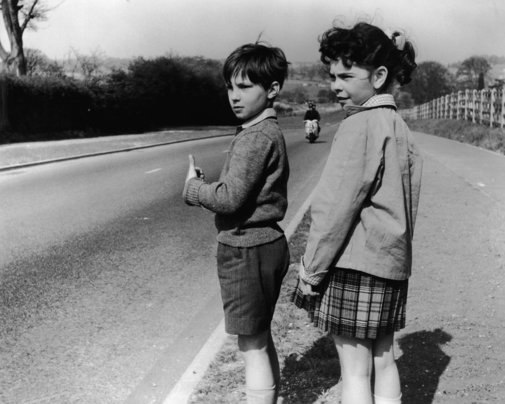|
Reviews of Recent Independent, Foreign, & Documentary Films in Theaters and DVD/Home Video

HAND IN HAND (1960) There’s something about certain kids’ films that hit a nerve like no other, and Philip Leacock’s Hand in Hand is no exception. This tale about the burgeoning friendship between a seven-year-old Jewish girl named Rachel and her seven-and-a-half-year-old Catholic friend, Mike, is potent, sly and deliciously disturbing. There have only been a few that jar to such an extent: Carol Reed’s The Fallen Angel (1948), René Clément’s Forbidden Games (1952), and of course, Robert Mulligan’s To Kill a Mockingbird (1962). So what is it that makes us feel that twinge of unease as we witness such simplicity, heartbreak, and joy? Could it be envy at our own innocence lost, or something more disquieting? We first meet Mike (Philip Needs) as he races between pedestrians and oncoming cars and finally arrives at Father Timothy’s church. “I’ve killed her…I’ve killed Rachel,” he cries. Of course his confessor doesn’t believe him. How could such things apply to this blonde waif with the face of a cherub? And so Father Tim sits Mike down, dries his eyes, and listens to the boy’s saga of Rachel. Mike first encounters Rachel (Loretta Parry) at a school choral recital. He’s in the audience, playing with his white mouse named Hector. She’s on stage, right in the front, as the star soloist. Of course, the black-haired songbird gets to the boy, so naturally, all he can do is trip her when she leaves the platform. They see each other every day after that. He even gives her Hector to keep. He patiently listens to the lonely girl’s fables about her imaginary sister, Miranda Ann, teaches her about Africa, lions, and how not to be afraid of the local ogre. They fix up an abandoned carriage house, become blood brothers (which is even better than marriage), and are inseparable in spite of the fact that she is a girl, and probably killed Christ. Leacock is a master filmmaker, employing only the barest of devices to portray life in a small British town. Beginning his career as a documentarian, Leacock spent the latter part of his vocation in American television. Staying true to his roots in documentary filmmaking, it’s not surprising that he chooses to use minimalist language, plot, and flashback. The result is a universal aura that grabs the viewer with a lingering sense of timelessness. Then there is his rare ability to direct small children and acquire moments of purity that feel so real. Carol Reed is recognized for these traits. So too, René Clément, and a tiny handful of other gifted directors. Astonishingly, these same talents are even more refined in the lesser-known work of Philip Leacock. Thanks to a
rerelease by Sony Pictures, we are able to watch Leacock’s magic unfold
as he parallels and collides an adult world of subtle intolerances with
that of childish wonder and forgiveness. Then as all fine storytellers
do, he leaves us to our own ambiguous conclusions.
Amy R. Handler
|

